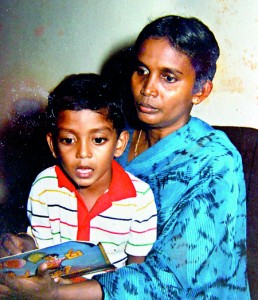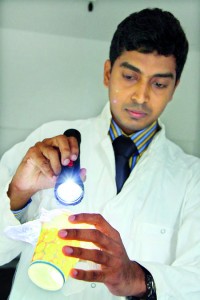Peering at insects, looking for answers

Mother & son: Neeta and Nayana
As a tiny-tot,Nayana, never attended Montessori. Even though his mother took him to school with her in their hometown of Gampaha and made him sit in the primary classes, until it was time for him to join Grade 1 formally, he would slip out surreptitiously, walk quietly into the science laboratory, climb onto a high stool and look on wide-eyed at the experiments his Amma was conducting for older children.
Science, he always wanted to pursue, unlike the obsession of many to become doctors and nothing else. Now as he sits in his office in the Department of Parasitology, University Kelaniya, he is one of the youngest Sri Lankans to have secured a doctorate.
Twenty-nine-year-old Dr. Nayana Gunathilaka was only 26 when he armed himself with a Ph.D in Molecular Medicine and Medical Entomology from the Faculty of Medicine, University of Kelaniya in 2014.
This is also not his only achievement. Without sitting on his laurels, he has conducted much research into subjects of importance to the world including Sri Lanka and has many publications to his credit.
Among the numerous awards Nayana has bagged are the Postgraduate Research Merit Award for Medical, Dental and Veterinary Sciences by the Sri Lanka Association for the Advancement of Science (SLAAS); the Vice Chancellorâs Award for Most Outstanding Young Researcher of the Faculty of Medicine, University of Kelaniya; the Vice Chancellorâs Award for Bringing Honour to the University of Kelaniya by winning national/international awards; and the Presidentâs Award for Scientific Publication in 2015 for highly-rated scientific research evaluated by peers.

A closer look at sandfly colonies. Pix by Indika Handuwala
He also has more than 96 publications under his name including full papers and presentations at national and international symposia, with over 50 citations.
Where his interests are, is obvious, for on his table amidst the papers and files are tiny transparent containers with mosquitoes in them, while just before we meet, he is heard giving instructions to two others on how to collect water samples from a dengue-rampant area close-by.
There has been nothing extraordinary in Nayanaâs life. Studying at the Hiripitiya and Kurikotuwa Kanishta Vidyalayas in Veyangoda, he joined the Bandaranaike Central College, Veyangoda, from where he did the Ordinary Level (O/L) and Advanced Level (A/L) Examinations.
While his father Harischandra was a textile manager, Nayana seems to have taken a cue from his mother, Neeta Wepola, who was a science teacher, for his career path. For, the roots of his âinitiationâ as a scientist are easily traceable to the experiments that his mother would conduct and he would be fascinated with, even as a very small boy.
âI always wanted to be a researcher and never a doctor,â smiles Nayana and it was to this end that he searched out how to achieve his dream.
The academic hurdles of O/L and A/L he surmounted without difficulty, following his undergraduate studies at the Kelaniya Universityâs Faculty of Science, emerging with a First Class Honours Bachelorâs Degree (B.Sc) in 2009.

Dr. Nayana Gunathilaka in the laboratory with his technical officers
It was while Nayana was working as a Medical Entomologist at the Malaria Elimination Programme of the Tropical and Environmental Disease and Health Associates (TEDHA), which was funded by the Global Fund to Fight AIDS,Tuberculosis and Malaria (GFATM), that a door to further studies opened up before him. Obtaining hisPh.D in Molecular Medicine and Medical Entomology from the Faculty of Medicine,University of Kelaniya in 2014, he also received training in advanced taxonomy onmedically-important mosquito vectors and molecular entomology at the World Health Organization (WHO) Collaborating Centre for Reference and Research of Arbovirus and their Associate Vectors in Singapore.
Working at TEDHA gave him much field-exposure as he crisscrossed the length and breadth of the country training, monitoring and evaluating 17 entomological teams comprising eight members each on vector-surveillance.
âWe roughed out,â says Nayana, recalling how as a 22-year-old he would be in Ampara, Batticaloa, Trincomalee, Kilinochchi and Mannar on different days, checking out mosquito-breeding habitats and slapping down mosquitoes which would swarm around his body in the night.
Thereafter, his career path took him as a Research Scientist to the Biotechnology Unit of the Industrial Technology Institute (ITI) in Colombo and finally to the seat of a Senior Lecturer at the Department of Parasitology, Faculty of Medicine, University of Kelaniya.
Now Nayana is not only peering at mosquitoes in his laboratory looking closely at the breeding habits of both the dengue and malaria vectors but also the sand-fly which is spreading leishmaniasis.
Currently, he is the Principal Investigator of the National Research Council-funded Investigator Driven Research Project 2016 on leishmaniasis and a Co-investigator of the NRC-funded Dengue Mega Project and WHO-funded Research Project on the âPotential use of a combined sterile insect technique (SIT) and Wolbachia-based approach for the control of the dengue vectors in Sri Lankaâ.
Nayana is also imparting his expertise and mentoring two Ph.D and four M.Phil students who are being supervised by him, in the fields of Molecular Biology, Community Medicine, Epidemiology, Medical Entomology and Molecular Entomology.
His pet research though is dengue, âa good avenue to go down as there seems to be limited expertiseâ in this field.
Set on promoting an inter-disciplinary research culture for the benefit of all, Nayana, however, is not just glued to his microscope.
âI used to play cricket and still indulge in a game of badminton. I am also in the church choir because I used to sing as a boy and have won First Place in all-island competitions,â smiles Nayana, reticent when asked whether marriage is on the cards soon and he has a girl-friend.


